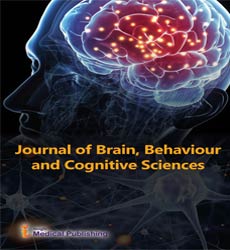Causal and Correlational Connections between Psychosocial Factors
Terry Sejnowski*
Department of Biological Sciences, University of California San Diego, CA, USA
- *Corresponding Author:
- Terry Sejnowski
Department of Biological Sciences,
University of California San Diego, CA,
USA,
E-mail: sejnowski.terry@gmail.com
Received date: August 01, 2023, Manuscript No. JBBCS-23-18033; Editor assigned date: August 04, 2023, PreQC No. JBBCS-23-18033 (PQ); Reviewed date: August 18, 2023, QC No. JBBCS-23-18033; Revised date: August 25, 2023, Manuscript No. JBBCS-23-18033 (R); Published date: September 01, 2023, DOI: 10.36648/jbbcs.6.3.21
Citation: Sejnowski T (2023) Causal and Correlational Connections between Psychosocial Factors. J Brain Behav Cogn Sci Vol.6 No.3: 21.
Description
The rise of brain research and conduct neuroscience as authentic sciences can be followed from the development of physiology from life systems, especially neuro anatomy. Clinicians' inclinations reach out to relational connections, mental flexibility, family versatility and different regions inside friendly brain research. They likewise consider the oblivious mind. Research clinicians utilize observational strategies to construe causal and correlational connections between psychosocial factors. Some, yet not all, clinical and directing therapists depend on representative translation. While mental information is frequently applied to the evaluation and treatment of emotional wellness issues, it is likewise coordinated towards understanding and tackling issues in a few circles of human movement. By many records, brain research eventually intends to benefit society. Many analysts are engaged with some sort of remedial job, rehearsing psychotherapy in clinical, guiding, or school settings. Different clinicians lead logical examination on a wide scope of themes connected with mental cycles and conduct. Normally the last option gathering of analysts work in scholastic settings (e.g., colleges, clinical schools or emergency clinics). One more gathering of therapists is utilized in modern and hierarchical settings. Yet others are associated with work on human turn of events, maturing, sports, wellbeing, measurable science, schooling and the media.
Development of Physiology
The word brain research gets from the Greek word mind, for soul or soul. Kant, nonetheless, unequivocally dismissed the possibility of an exploratory brain science, composing that the exact convention of the spirit can likewise never move toward science even as an efficient specialty of investigation or trial tenet, for in it the complex of inward perception can be isolated exclusively by simple division in thought and can't then be held discrete and recombined freely yet less does one more reasoning subject endure himself to be tested upon to suit our motivation and even perception without help from anyone else as of now changes and uproots the condition of the noticed item. In any case, this discipline didn't yet embrace experimentation. In England, early brain science included phrenology and the reaction to social issues including liquor abuse, viciousness and the nation's packed neurotic shelters. Thinker John Stuart Mill accepted that the human brain was available to logical examination, regardless of whether the science is here and there inexact. Mill proposed a psychological science in which rudimentary considerations could join into thoughts of more prominent complexity. Gustav Fechner started directing psychophysics research in Leipzig during the 1830s. He explained the rule that human impression of an upgrade changes logarithmically as per its intensity. The guideline became known as the Weber-Fechner regulation. Fechner's 1860 elements of psychophysics provoked Kant’s negative view concerning directing quantitative examination on the mind. Fechner's accomplishment was to demonstrate the way that psychological cycles couldn't be given mathematical sizes, yet in addition that these could be estimated by trial methods. In Heidelberg, Hermann led equal exploration on tangible discernment and prepared physiologist Wundt. Wundt, thus, came to Leipzig University, where he laid out the mental research facility that carried exploratory brain science to the world. Wundt zeroed in on breaking down mental cycles into the most essential parts, roused partially by a similarity to late advances in science and its fruitful examination of the components and construction of materials. Paul and Emil before long made one more compelling lab at Leipzig, a brain research related lab that zeroed in more on trial psychiatry. Brain science is the logical investigation of psyche and conduct.
Investigation of Neurobiological Cycles
Brain science incorporates the investigation of cognizant and oblivious peculiarities, including sentiments and contemplations. It is a scholastic discipline of tremendous extension, crossing the limits between the regular and sociologies. Clinicians look for a comprehension of the rising properties of cerebrums, connecting the discipline to neuroscience. As friendly researchers, analysts intend to grasp the way of behaving of people and groups. An expert professional or specialist associated with the discipline is known as a clinician. A few analysts can likewise be named conduct or mental researchers. A few analysts endeavor to grasp the job of mental capacities in individual and social way of behaving. Others investigate the physiological and neurobiological cycles that underlie mental capacities and ways of behaving.
Open Access Journals
- Aquaculture & Veterinary Science
- Chemistry & Chemical Sciences
- Clinical Sciences
- Engineering
- General Science
- Genetics & Molecular Biology
- Health Care & Nursing
- Immunology & Microbiology
- Materials Science
- Mathematics & Physics
- Medical Sciences
- Neurology & Psychiatry
- Oncology & Cancer Science
- Pharmaceutical Sciences
